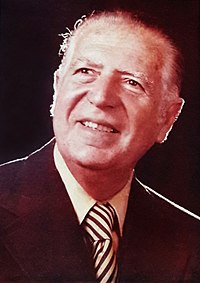Fernando Belaúnde Terry
Fernando Belaúnde Terry (October 7, 1912 – June 4, 2002) was a Peruvian politician. He was President of Peru (1963–1968 and 1980–1985).[1]
Fernando Belaúnde Terry | |
|---|---|
 | |
| 49th and 52nd President of Peru | |
| In office 28 July 1980 – 28 July 1985 | |
| Prime Minister | Manuel Ulloa Elías Fernando Schwalb López Aldana Sandro Mariátegui Chiappe Luis Pércovich Roca |
| Vice President | Fernando Schwalb López Aldana Javier Alva Orlandini |
| Preceded by | Francisco Morales Bermúdez (President of the Armed Forces Revolutionary Government) |
| Succeeded by | Alan García |
| In office 28 July 1963 – 3 October 1968 | |
| Prime Minister | Julio Óscar Trelles Montes Fernando Schwalb López Aldana Daniel Becerra de la Flor Edgardo Seoane Corrales Raúl Ferrero Rebagliati Oswaldo Hercelles García Miguel Mujica Gallo |
| Vice President | Edgardo Seoane Mario Polar Ugarteche |
| Preceded by | Nicolás Lindley López (President of the Military Junta) |
| Succeeded by | Juan Velasco Alvarado (President of the Armed Forces Revolutionary Government) |
| Senator for Life Former President of the Republic | |
| In office 26 July 1985 – 5 April 1992 | |
| Member of the Chamber of Deputies | |
| In office 28 July 1945 – 29 October 1948 | |
| Constituency | Lima |
| Leader of Popular Action | |
| In office 1956–2001 | |
| Preceded by | Party Founded |
| Succeeded by | Valentín Paniagua (Party President) |
| Personal details | |
| Born | 7 October 1912 Lima, Peru |
| Died | 4 June 2002 (aged 89) Lima, Peru |
| Nationality | |
| Political party | Popular Action |
| Spouse(s) | Violeta Correa Miller Carola Aubry Bravo |
| Children | 3 |
| Alma mater | University of Miami University of Texas at Austin |
| Profession | Architect |
Early life and education
The second of four children, Belaúnde was born in Lima into an aristocratic family of Spanish forebears: his father, Rafael Belaúnde Diez Canseco (1886–1972), a professor, served as Prime Minister under José Bustamante y Rivero; his paternal grandfather, Mariano Andrés Belaunde was a Finance Minister; and one of his great-grandfathers, Pedro Diez Canseco, was also President of the Republic.[2]
He attended the Sagrados Corazones Recoleta in Lima.[3]
During the dictatorship of Augusto B. Leguía, the persecution for the political activities of his father Rafael and his uncle Víctor Andrés Belaúnde prompted the family to move to France in 1924, where Fernando attended high school and received his initial University education in engineering.
From 1930 to 1935, Belaúnde studied architecture in the United States, where he first attended the University of Miami(where his father was also teaching), and in 1935 transferred to the University of Texas at Austin, where he obtained his degree as an architect. He later moved to Mexico and worked as an architect for a brief time, but returned to Peru in 1936 and started his professional career as an architect designing private homes. In 1937, he started a magazine called El Arquitecto Peruano ("Peruvian Architect"), which dealt with interior design, general urbanism and housing problems the country was facing. This also gave way to the Architects Association of Peru and the Urbanism Institute of Peru.
As a result, Belaúnde also became a government public-housing consultant throughout the country and abroad. In 1943, Belaúnde began teaching architecture and urban planning at Escuela Nacional de Ingenieros of Lima and later became the dean of the Civil Engineering and Architecture department. Belaúnde also directed the construction, along with other professors and students, of the faculty of architecture of the National University of Engineering in 1955.
References
- ↑ "Peru mourns death of 'model democrat'" (BBC News)
- ↑ Gunther, John, Inside South America, p. 322
- ↑ Novak, Fabián. Las relaciones entre el Perú y Alemania, 1828–2003 (Serie Política exterior peruana). Fondo Editorial PUCP, 2004. ISBN 9972426343, 9789972426346. p. 45.
Other websites
- Página oficial de Acción Popular.
- Extended biography by CIDOB Foundation (in Spanish)
- El Arquitecto Peruano, Belaúnde's magazine (Spanish and English)
- Fernando Belaunde Terry recorded at the Library of Congress for the Hispanic Division’s audio literary archive on Apr. 22, 1977